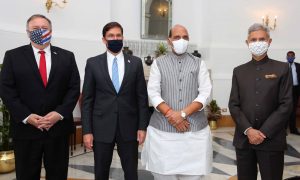India and the United States held the third edition of their annual “2+2” defense and foreign ministers’ dialogue on October 27 in New Delhi. The day before, Indian Defense Minister Rajnath Singh and External Affairs Minister S. Jaishankar also held one-on-one meetings with their U.S. counterparts, Secretary of Defense Mark Esper and Secretary of State Mike Pompeo. These discussions come amid dramatic deepening of defense ties between the two countries in recent years. Earlier this month, on October 6, Jaishankar and Pompeo had met on the sidelines of the Australia-India-Japan-United States Quad dialogue in Tokyo.
India and the United States also signed the Basic Exchange and Cooperation Agreement for Geo-Spatial Cooperation (BECA) on the sidelines of Esper and Pompeo’s visit, as was widely expected. BECA, the last of the four “foundational” defense agreements between the two countries, is arguably also the most sophisticated. By enabling India to access a range of classified U.S. geospatial intelligence, it stands to greatly enhance India’s ability to carry out precision strikes using an array of manned and unmanned vehicles. BECA also paves the way for India to acquire U.S. platforms such as Predator-B drones that use such targeting data.
In February this year, during President Donald Trump’s visit to India, both countries had declared their relationship to be a “Comprehensive Global Strategic Partnership.” And while it is easy to dismiss this moniker as flattering but ultimately meaningless, the fact of the matter is that India-U.S. defense and strategic cooperation, both bilaterally as well as in small groupings such as the Quad, has acquired substantial depth. The long and detailed joint statement following the 2+2 meeting attest to this.
Four things from the statement stand out. (While some of these are reiterations from last year’s joint statement, subtle shifts in language and accent make them interesting.)
First, under the header of regional Indo-Pacific issues, it notes that both sides agreed that “the Code of Conduct in the South China Sea should not prejudice the legitimate rights and interests of any nation in accordance with international law.” This explicit reference to a future Code of Conduct (COC) in the South China Sea that helps push back against China’s activities there is an addition to last year’s joint statement. While the 10-member Association of Southeast Asian Nations once again called for a COC in August, observers fear Beijing continues to nudge the talks in a direction unpalatable for all except itself – within and outside the region.
Second, the joint statement discusses the role of infrastructure development, both in India and in the region. While last year’s joint statement had only mentioned their support for “sustainable and transparent infrastructure investment” in the Indo-Pacific, this year’s explicitly focuses on several details, including “welcoming” a permanent presence of the U.S. International Development Finance Cooperation (DFC) in India. (Earlier this year, in June, the DFC had announced a large tranche of loans for projects across the world, including in India.) But perhaps more significant is the assertion in the joint statement that both countries are looking “forward to exploring ways to cooperate under the Blue Dot Network [BDN].” The BDN is, effectively, a mechanism to draw a plethora of actors around “transparent, competitive, market-driven system [for infrastructure development] that is mutually beneficial for all involved,” as Pompeo has described it in the past. Some Indian analysts had already argued in favor of India joining the BDN, both out of geoeconomic as well as geostrategic considerations.
Third, the reassertion of capabilities of both sides to jointly and securely monitor and exchange positions (implicitly, on Chinese military activity in the Indian Ocean region and elsewhere) in the joint statement was meant to carry a strategic signal for Beijing. The joint statement’s accent on India and the United States’ ability to securely communicate information – which indicates substantial progress in implementing the 2018 India-U.S. Communications Compatibility and Security Agreement (COMCASA) – both at the political as well as the operational level, between Indian and U.S. armed forces, will undoubtedly be noted in Beijing. It come at a time when the Indian military is explicitly seeking to keep a close eye on China’s naval activity along its sea lanes of communications and in India’s maritime vicinity.
Fourth, there is an emphasis on even greater concrete military coordination, and again interesting reiterations. For example, this year’s joint statement mentions that India and the U.S. “looked forward to interaction between the Special Forces of India and the United States.” Given that Indian and U.S. special forces already exercise jointly – through Vajra Parahar, which is also mentioned in the statement, separately – one is left wondering whether the mention was in the context of a separate special forces-to-special forces engagement beyond exercises. (While last year’s joint statement too had a similar mention of special forces engagement, this year’s language is more definitive.) This year’s joint statement – unlike last year’s – has an explicit mention of joint training of both militaries. Much more significantly, however, was the explicit mention of the importance of passage exercises (PASSEX) between the Indian and U.S. navies in this year’s statement – again, undoubtedly, something China will take note of.
All in all, going by the joint statement, as well as the opening remarks of the four ministers, this year’s iteration of the 2+2 dialogue was substantially franker – and both sides have China to thank for that. Singh took the opportunity to flag “reckless aggression on our [Indian] northern borders” in his opening remarks – which tells you all you need to know about what really was discussed beyond the detailed diplomatese of the joint statement.

































